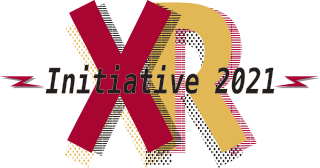It's been 20 years since the introduction of Second Life, an online multimedia platform that let users create their own avatar and then interact with others in a virtual world. When Second Life first came out, I remember faculty coming to the teaching center wanting to see how they could use it for their classes. They didn't necessarily know how they were going to use the technology, just that it was something new and engaging. We soon ran into the sizable learning curve and high expense of interacting in the virtual world. Many faculty did not have the time and resources needed to devote to this single technology, especially when it may or may not have been helpful for their students.

Randy Newbrough
Manager, Campus Centers for Teaching and Learning
Assistant Director, IUPUI Center for Teaching and Learning
Newbrough also oversees the Extended Reality Initiative (XRI)
What is Extended Reality (XR)?
XR is the umbrella term for:
- Virtual reality (VR), a completely immersive experience
- Augmented reality (AR), which adds digital elements to a real-world view
- Mixed reality (MR), which combines AR and VR for interaction between real-world and digital objects
The X represents the potential for future immersive technologies to be developed.
Fast forward to our present time and once again, we are starting to see increased interest in extended realities (XR) such as Virtual Reality (VR), Augmented Reality (AR), and Mixed Reality (MR). These technologies are intended to enhance a user's experience by adding digital, auditory, olfactory, and haptic elements to mimic and enhance "real life." The difference now is that these technologies are more streamlined and cost effective, and the learning curve is not so steep.
The literature surrounding the use of XR technologies in higher education shows that students are more present and engaged when using them and that they can help deepen understanding of complex concepts. XR is also effective for active and experiential learning that helps students gain experiences that might not otherwise be available. Graduates are entering a workforce being shaped by a variety of technologies. By offering opportunities and exposure now, we can help students be better prepared once they leave IU.

When I launched the Extended Reality Initiative (XRI) Faculty Fellows Grant on the IUPUI campus, thanks to funding from the Chancellor's office, my main objective was to provide faculty with opportunities to begin incorporating these technologies into their courses. I wanted to make the process such that they did not have to know anything about VR or AR, but simply have the desire to try something new that might help their students better understand a difficult course concept or have a better experience around certain course content.
Read this issue's Featured Story on Steven Overbey, whose XRI fellowship focused on piloting what ultimately became the VR Speech Lab.
By pulling together various people who were already working with these technologies, I was able to provide the necessary support and resources for faculty to start experimenting and incorporating them into courses through a simple activity, project, or assignment. The process didn't have to involve a complete overhaul of the course, just one area in the curriculum that could be enhanced with the use of these technologies.
Over the past two years, twelve faculty members on the IUPUI, IUPUC, and IU Fort Wayne campuses have received grants to incorporate XR into their courses. This year, the XRI Grants are expanding to IU Bloomington thanks to funding from UITS. As more faculty begin to look at ways to better engage their students, I hope to be able to continue expanding this initiative and give faculty and students across IU opportunities to engage with course content in new and exciting ways.

